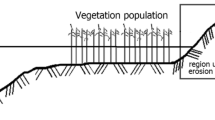Abstract
Quantitative investigations and research conducted along the north coast of New South Wales, Australia are evaluated with respect to coastal processes, coastal alignment, meteorological data, dune dimensions, dune vegetative cover, development on the dunal area and dune management.
The data available covered an assessment of the extent of dune instabilities, an assessment of long term coastline movements, a study of the effect of a cyclone and storm surge, and an assessment and evaluation of a phase of extreme coastline erosion. Specific situations are described and evaluated within the above context. The evaluations are used to determine the extent of coastal dune areas required to be designated as “buffer zone” in land use planning. The extent of the zone required is dependent upon “expected” magnitude of wave erosion. Magnitude of wave erosion was found to be proportional to the interaction of coastal processes during periods of extreme erosive factors and the beach dune characteristics for the particular section of coastline. It was found that man's influence on this natural interaction can be a dominating factor in determining beach dune characteristics and therefore the magnitude of wave erosion. — management of the beach dunal area to maintain an “acceptable” dynamic equilibrium of the beach dune line by a vegetated sand dune of specific dimensions is possible despite weather conditions, if a designated buffer zone is maintained.
Similar content being viewed by others
References
FOSTER, D. N. (1974a): Beach Protection Cronulla Report No. 1. University of New South Wales, Water Research Laboratory Tech. Report 74/19 Oct. 1974, Sydney.
FOSTER, D. N. (1974b): The Beach Erosion Hazard. Water Research Foundation of Australia Report No. 44, Sydney.
FOSTER, D. N., GORDON, A. D. and LAWSON, N. V. (1975): The Storms of May–June 1974, Sydney, N.S.W. Proc. Second Australian Conference on Coastal and Ocean Engineering, The Institute of Engineers, Australia National Conference Publication No. 75/2, Canberra, 1–11.
IPPEN, A. T. (1966): Estuary and Coastline Hydrodynamics. McGraw Hill, New York.
HOPLEY, D. (1965): Beach Erosion and Accretion at Byron Bay, N.S.W. ANZAAS Proceedings, Hobart, Australia.
HOPLEY, D. (1974): Australian weather example No. 2 storm surge. Aust. Geogr., 12:462–468.
LANGFORD-SMITH, T. and THOM, B. G. (1969): New South Wales coastal morphology. The geology of New South Wales. Geol. Soc. Aust., 16: 16:572–580.
MCLEAN, R. F. and THOM, B. G. (1975): Beach Changes at Moruya, 1972–1974. Proc. Second Australian Conference on Coastal and Ocean Engineering, The Institute of Engineers, Australia National Conference Publication No. 75/2, 12–17, Canberra.
MORT, G. W. (1949): Vegetation survey of the marine drifts of New South Wales. J. Soil Cons. N.S.W., 5:84–91.
NELSON, R. C. (1975): Tropical Cyclone Storm Surges in Australia 1880–1970. Proc. Second Australian Conference on Coastal and Ocean Engineering, The Institute of Engineers, Australia, National Conference Publication No. 75/2, Canberra.
SKIDMORE, E. L. (1968): Wind Erosion forces in the United States and their use in predicting soil loss. Agriculture Handbook 346, U.S. Department of Agriculture, Government Printer, Washington.
THOM, B. G., MCLEAN, R. F., LANGFORD-SMITH, T. L. and ELIOT, I. (1973): Seasonal Beach Change, Central and South Coast, N.S.W. Proc. First Australian Conference on Coastal Engineering, Institution of Engineers, Australia, National Conference Publication No. 73/1, 35–42 Canberra.
WATT, B. G. (1972): An assessment of coastal sand drift in New South Wales. J. Soil Cons. N.S.W., 28:7–21.
WATT, B. G. (1976): Coastal sand drift. J. Soil Cons. N.S.W., 32:202.
WEARNE, A. H. and QUILTY, J. A. (1974): Frontal dune studies: the effects of cyclone Pam. J. Soil Cons. N.S.W., 30:201–212.
WEARNE, A. H. and QUILTY, J. A. (1975): An evaluation of an extreme phase of coastal erosion. J. Soil Cons. N.S.W., 31:179–192.
Author information
Authors and Affiliations
Rights and permissions
About this article
Cite this article
Watt, B.G. Coastal dune stability: The effect of meteorological conditions and vegetation. Int J Biometeorol 21, 189–202 (1977). https://doi.org/10.1007/BF01552873
Issue Date:
DOI: https://doi.org/10.1007/BF01552873




